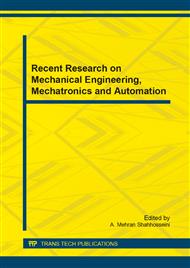p.665
p.672
p.679
p.684
p.690
p.696
p.702
p.708
p.712
Sparse Representation of Vibration Signals Using Trained Dictionary
Abstract:
The sparsity of a signal is critical for compression and high compression performance is obtained by utterly sparse signal. But real signals are not sparse commonly, so sparse transformation is considered. In addition, the sparse degree of coefficients is mainly determined by the quality of transform base. Therefore, this paper constructs a transform base (trained dictionary) by K-SVD algorithm for rolling element bearing vibration signals and uses the Orthogonal Matching Pursuit (OMP) algorithm to conduct sparse representation and simulation. Results show that the trained dictionary can be more fitted with the features of signals, the residual components are smaller and the reconstruct similarity is higher compared to the untrained dictionaries, obtaining better representation.
Info:
Periodical:
Pages:
690-695
Citation:
Online since:
July 2014
Authors:
Price:
Сopyright:
© 2014 Trans Tech Publications Ltd. All Rights Reserved
Share:
Citation:


